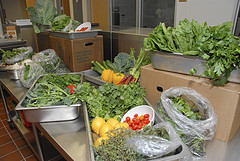Celebrity cooking shows are popular around Brent Ozar Unlimited®. We watch Top Chef for the creative cooking as much as the human drama. Contestants on Top Chef face huge challenges – they’re working alone, have a limited set of tools, have a fixed set of ingredients, and operate under ridiculously strict time guidelines. What makes the creativity of chefs even more interesting is the limitations they’re under: contestants have to work with strange, disgusting or difficult ingredients in order to win the favor of the judges.
Building successful software isn’t much different. Sure, there’s a team of collaborators to help us make decisions; but everyone on that team is frequently responsible for one area of the application. Success or failure depends on your ability to work with the requirements you’re given and please the final judges – the end users.

The Rules of the Contest
Top Chef contestants work within the rules of the contest – they have a limited amount of time with a limited number of ingredients to make an appealing meal. The core ingredients and the time period are non-negotiable. The show’s producers call these the rules, in the world of software these are business requirements, and in the world of programming we might call these application invariants. But no matter what you call them, these things can’t change. Requirements might be something like
- A picture can’t be viewed until four thumbnails have been generated.
- Property listings cannot be viewed until approved by the listing agent.
Contestants on Top Chef don’t immediately start cooking – although careful editing makes it look that way. Development teams, even agile teams, shouldn’t get immediately start coding once they have their hands on requirements. It’s important to look carefully at the requirements and make sure it’s possible to deliver something that the business (the judges) are happy to see. Winning chefs don’t immediately reach for a bottle of Frank’s Red Hot to give a dish a bit of pizzazz, they consider all of the options and match their condiments to the meal, so why do we always reach for the same tools?
It’s easy to be lulled by the familiar – hot dogs and burgers are easy, but they don’t win Top Chef. While you don’t need award winning code to win the game of delivering software, you do need to make the right choices to make life easier.
Working with black chicken and monkfish liver may not be the easiest thing, but contestants on Top Chef are routinely able to turn strange ingredients into masterpieces. Business requirements spell out how our applications have to behave at the end of the day, but you’ll notice that it doesn’t matter how you get there. Just make sure you get there – solve the business problem and move on.
Start with the Ingredients
It isn’t uncommon for Top Chef contestants to scrap their first ideas after a few minutes of work. Likewise, don’t be afraid to throw away your first idea. If you’re a pack rat, write your idea on a piece of paper and hide it from yourself. It’s okay to come back to your first idea, but it’s important to think about the problem in a different way.
What are the core ingredients of your application? Just because you have chicken, that doesn’t mean you should make chicken cordon bleu. Ask yourself, “What am I supposed to create?” A few applications I’ve come across in the last year are:
- Single sign-on systems
- Hosted property listings
- Utility easement tracking
- Document tracking and signing
Each of these applications has a different set of features and functionality. Would you use the same solution for each one? Looking at it a different way – would you serve the same meal for the Superbowl as you would for Christmas dinner?
Make an itemized list of the ingredients that you have on hand. Your requirements are your ingredients. They drive the way the users will interact with the data. As you investigate the requirements, make sure you ask the users questions like, “Do you need point in time recovery for easement property maps?” or “Is it a requirement that a user have a first name, last name, bio, and profile picture or would a user name and password be acceptable?” Understanding your requirements drives your choices.
It’s All About the Ingredients
Under all of your application code, you need somewhere to store your data. One of the Top Chef judges frequently asks “Where’s the protein?” when served a salad. As you work through application requirements, use these to ask yourself “Where’s the data?”
Top Chef contestants typically aren’t told that they need to make sweet glazed salmon, they’re told to use a set of ingredients and produce a fine meal. It’s up to the chef to determine whether to use rémoulade or tartar sauce and it’s up to you to make technical decisions. The business user isn’t going to know the answers to your technical questions, but they do know that a user only needs a user name and password to use the application.
Use the business requirements to help make your database design decisions – if an image doesn’t need to be transactionally consistent with all other data, you don’t need to store it in your relational database. The rules of the contest – the business requirements – should shape how you design your application. They give you both the restrictions and freedom you need to be creative.
What Will They Eat?
Food falls into distinct cuisines. If I gave you a choice between sushi or tapas, you’d be able to make an informed choice because you know the ingredients and style used for each style of cooking.

As you evaluate the business requirements, dig deeper and imagine the types of answers that users might look for in the data. Will users look for property along the path of a tornado where repairs need to be made? Are users searching for houses with specific features – e.g. find single family homes with 2 or more bathrooms and an attached garage? Or are users’ questions difficult to predict and completely free form?
Understanding how people will use the data guides the choices we make. If users will be performing free form text searches, a full text search engine like SOLR should be considered. If an application is pure OLTP, it’s possible that you can use a key-value database. Understanding application requirements means that you can decide whether you need to use SQL Server or you can investigate other options.
Some of the database cuisines to consider are:
- Relational database (SQL Server, PostgreSQL)
- Document database (CouchDB, MongoDB)
- Text Search (Lucene/SOLR, Elastic Search)
- Key-Value database (Riak, Cassandra)
The processing of picking a database can lead to conflict. Developers have their favorite new technologies they want to try and entrenched products are frequently favored above all others. Understanding how one database meets application requirements is important – if you don’t know which ingredients you have, you don’t know what to make; if you don’t understand the application invariants involved, you can’t know which option is the best.
Ultimately, making sure you pick the right tool for the job can lead to faster development, easier support, and better throughput.

What Do the Judges Think?
The most important thing, though, is what the judges think. It doesn’t matter if you’ve made the greatest chicken salad sandwich ever, if your work doesn’t meld with the judges’ expectations you won’t be taking home the prize. Understanding how the requirements influence the ways that users will work with data is critical if you want to be successful. Once you know how people will work with the tools, you’ll be able to make the right decisions for your application.

